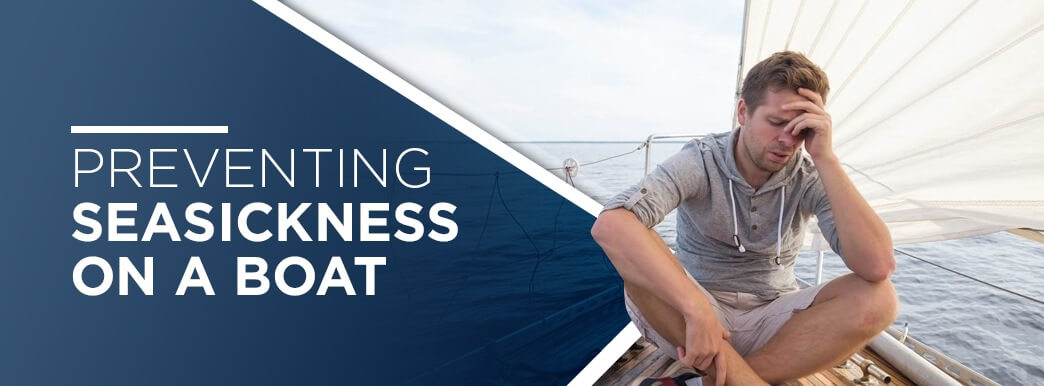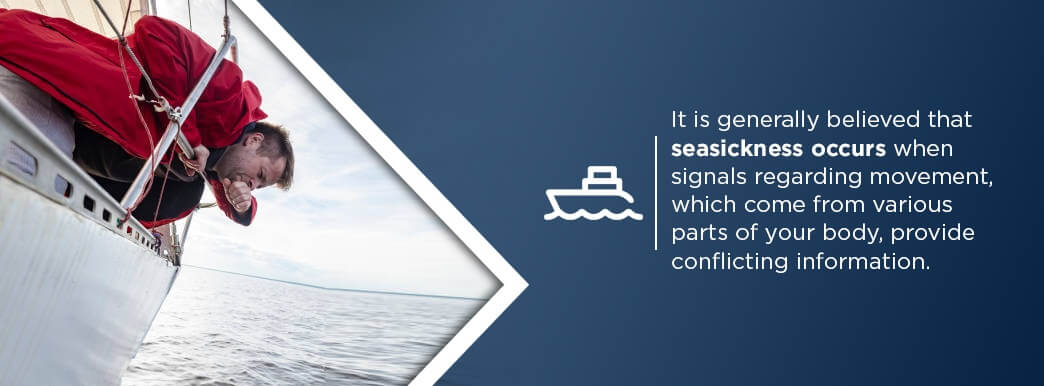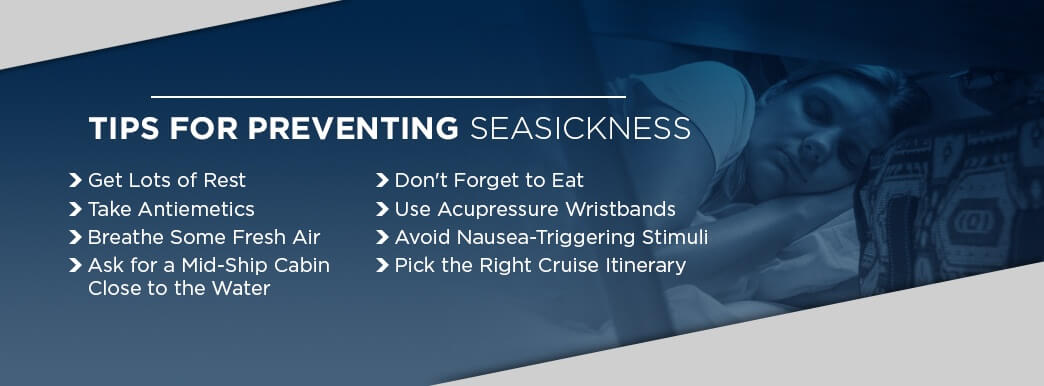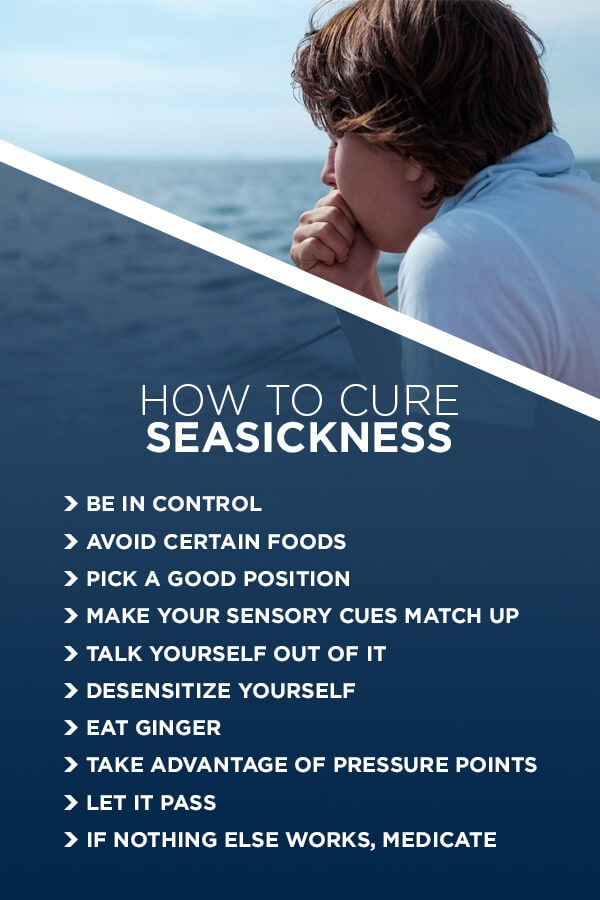
Seasickness — which is more generally referred to as motion sickness — is an unpleasant feeling caused by any motion that disturbs your inner ear, including everything from boat rides to roller coasters. While the symptoms are mild for some, they are incapacitating for others and can include nausea and vomiting. If you’re a sufferer of this inner ear disturbance, read our helpful guide to learn about what causes motion sickness as well as how to prevent and cure this malady.
Causes of Seasickness
Motion sickness can be caused by any mode of travel, including cars, buses, boats or planes. Some other experiences known to induce this queasy feeling include:
- – Amusement park rides
- – Playground equipment
- – Virtual reality
- – 3D movies
- – Seeing others’ movement
The groups most susceptible to motion sickness include:
- – Women, especially if they’re pregnant, menstruating or receiving hormone therapy
- – Children between the ages of 2 and 12
- – People prone to migraines
Some of the most common risk factors include:
- Anxiety or fear about travel or becoming motion sick
- Insufficient ventilation, including exposure to smoke or fumes
- Being on certain medications, which include some antidepressants, asthma medicines, antibiotics and narcotics
How Seasickness Works

It is generally believed that seasickness occurs when signals regarding movement, which come from various parts of your body, provide conflicting information. Your brain detects movement by gathering signals from your inner ears, eyes, muscles and joints. If your eyes tell your brain that your body is not moving — for instance, if you’re in a car that’s moving, it looks stationary to you — but your inner ears send signals that your body is moving, this creates a conflict. This sensory mismatch, researchers believe, is what causes the feelings of seasickness.
Symptoms of Seasickness
You are probably familiar with some of the most common symptoms of motion sickness such as nausea, dizziness and vomiting. Other symptoms may include:
- Sweating
- Pallor
- Shortness of breath
- Hyperventilation
- Drooling
- Drowsiness
- Fatigue
- Mild abdominal discomfort
- General uncomfortable feeling
- Headache
- Inability to concentrate
- Focal weakness
- Increase in production of saliva
Although rare, if someone with motion sickness vomits for a prolonged period, they may become dehydrated and develop depression, inanition and hypotension.
If a person is continually exposed to motion, they will typically adapt within a few days, although symptoms may return if the motion intensifies or resumes following a brief respite.
Tips for Preventing Seasickness

Luckily, there are several strategies for preventing motion sickness, which include:
1. GET LOTS OF REST
Lack of sleep and exhaustion will increase your susceptibility to seasickness. Before traveling or engaging in an activity that may cause motion sickness, take the time to get plenty of rest.
2. TAKE ANTIEMETICS
There are various medications on the market for the treatment of motion sickness. Antiemetic drugs, which are medicines that help prevent nausea, include Dramamine and Bonine, which do not require a prescription, as well as scopolamine drugs, which are prescription drugs available in patch and pill form. The majority of these treatments are designed to counteract the effects of the chemicals your brain releases when you’re seasick. Ask your doctor about the best medication for you. Be aware that antihistamines may make you drowsy and dry out your eyes and mouth. Antihistamines work by blocking messages in your brain that control vomiting and nausea, so medications like Dramamine are most effective if you take them before you feel seasick.
3. BREATHE SOME FRESH AIR
When seasickness strikes, it’s often a good idea to go to a balcony or open deck and focus, on the horizon. This will help you “see” the movement, and your eyes will now send your brain signals that better match what your inner ear detects. Fresh air, particularly if the wind is blowing, often helps. You should also concentrate on something besides the motion of the boat, so make sure to stay active while you’re on board.
4. ASK FOR A MID-SHIP CABIN CLOSE TO THE WATER
In the center of a boat, seasickness-inducing motion, namely the sawing side-to-side and seesawing up-and-down, is minimal. If you’re going on a cruise, request a cabin near the middle of the ship if you can. It’s also not a bad idea to ask for a room that has a portal or window, which will let you see the horizon more easily.
5. DON’T FORGET TO EAT
Bland, light foods, like pretzels, plain bread and saltine crackers, are the best for preventing seasickness. While having something in your belly is preferable to nothing, make sure not to overeat. As for drinks, we recommend ginger ale, a famous treatment for seasickness. You may also be able to calm your stomach with some peppermint. Eating crackers while drinking soda or water is also effective for many people.
6. USE ACUPRESSURE WRISTBANDS
This type of wristband, also known as a Sea-Band, applies pressure at a certain area of your wrist. Many find that this pressure helps them to prevent nausea. Acupressure wristbands are often available in pharmacies and from many online stores.
7. AVOID NAUSEA-TRIGGERING STIMULI
Nausea is perhaps the most characteristic symptom of seasickness, and anything that can trigger nausea could make your seasickness symptoms worse. These triggers include consuming spicy foods, greasy foods, acidic foods and large amounts of food of any kind. You should also avoid alcohol, which accelerates dehydration and may weaken your resistance to seasickness. Instead, drink plenty of water. Stay away from noxious smells and others near you who are suffering from motion sickness and throwing up.
8. PICK THE RIGHT CRUISE ITINERARY
If you’re particularly prone to seasickness, you should stick to bigger ships and choose routes that traverse calmer waters. For example, the Caribbean is generally calmer than many other places in the Atlantic. You may also want to consider newer ships, which feature cutting-edge stabilization systems that help reduce the feeling of motion.
How to Cure Seasickness

Consider the following motion sickness remedies to cure seasickness for good:
1. BE IN CONTROL
If you’re traveling in a boat or car, it’s easy to get motion sick if you’re not the one driving. The driver is less susceptible to motion sickness than the passengers because they are controlling it and know where it will go next. If you get queasy easily, take control of the wheel to minimize your chances of motion sickness. If you’re not able to drive, at least try to sit up front and look far ahead, which will make you feel more in control than you would in the backseat. If you must sit in the back, try to pick a seat where you can still look out the front. Try to get some fresh air by opening a vent or other fresh air source, and avoid looking down at your phone or reading a book.
2. AVOID CERTAIN FOODS
Refrain from drinking too much alcohol, smoking and eating liquids or foods that are particularly filling. Foods that are heavy, spicy or have strong odors may aggravate your motion sickness symptoms.
3. PICK A GOOD POSITION
Find a spot that experiences minimal motion. To prevent seasickness on a boat, try moving to a cabin on a lower level that is located near the ship’s center. If you’re on an airplane, we recommend picking a seat above the wing, which is calmer than anywhere else on the plane. If you hear others near you suffering or complaining about their motion sickness, try to stay away from them — just listening to other people talking about it or seeing them getting ill can exacerbate your own motion sickness symptoms.
4. MAKE YOUR SENSORY CUES MATCH UP
If you’re feeling seasick, try lying down so that the sensory systems in your body become congruent. On trains, you should find a seat that faces forward, which will allow your eyes to send the same movement signals to your brain that the inner ear is sending. If on a boat or in a car, it’s often helpful to fix your gaze on a certain point ahead of you. The more sensory congruence is enhanced, the lower your chances of feeling motion sick.
5. TALK YOURSELF OUT OF IT
It’s true — you can actually convince yourself you’re not seasick. According to the results of a study, just telling sailors that they won’t become seasick has helped to prevent seasickness. Before you travel, use affirmative language with yourself like, “I won’t get seasick this time.” Using breathing techniques involving biofeedback may also be helpful.
6. DESENSITIZE YOURSELF
Desensitization is effective for reducing — and sometimes even curing — seasickness. Think of some activities that cause motion sickness for you, engage in them for short amounts of time, making the periods a little longer each time. For instance, if reading in a vehicle when it’s in motion makes you nauseated, read for a five-minute interval and then put down the book. Repeat this interval for a few sessions, then increase the time to ten minutes. You’ll find that, over time, you’ll become more accustomed to it.
7. EAT GINGER
Certain studies have found that eating ginger is effective in preventing seasickness. Although not proven, this is a safe remedy that’s worth a try, especially if your symptoms are mild. Ginger root, which is most commonly sold in capsules and candies, is the type with the most evidence to support it. It’s also considered safe for pregnant women. For the best results, take a gram or two of ginger 30 minutes before you travel. If you take blood thinners, you should speak with your doctor first about taking ginger.
8. TAKE ADVANTAGE OF PRESSURE POINTS
Although the jury is still out on this method, acupressure is worth trying — even if it just serves as a placebo. As we mentioned earlier, you may be able to avoid motion sickness simply by convincing yourself that you can. If you can better convince yourself that you won’t get motion sick by wearing a pressure point device like a wristband with bumps, it’s definitely worth trying out. Magnets, however, are not worth spending money on — while you may have heard of this method, there is no evidence that magnets marketed for treating motion sickness are effective at all.
9. LET IT PASS
Keep in mind that, no matter how sick you feel, your seasickness will clear up by itself after three days or so. If your kids are suffering from seasickness, let them know that this awful condition should start to go away after they turn 12. This information should make them feel better, knowing that they won’t be doomed to seasickness for their entire lives.
10. IF NOTHING ELSE WORKS, MEDICATE
If you’re prone to severe motion sickness, we encourage you to take medications like meclizine or Dramamine, which you can get over-the-counter. These work best if taken half an hour to an hour before you think the motion sickness will hit you. If you’re an adult in good health, you can also speak with your doctor about taking scopolamine, which comes in the form of a patch, to deal with prolonged episodes of motion sickness. You should be aware that these medications can cause dry mouth, drowsiness and several other undesirable side effects.
Here is a brief overview of drugs commonly used to treat motion sickness:
- Antihistamines: Benadryl, Dramamine and other older, non-prescription antihistamines are well-known to counteract the effects of motion sickness. The FDA has also approved them for children over 2 years old to use. The main downsides are that they cause drowsiness and take up to 60 minutes to take effect. Non-sedating, newer OTC antihistamines like Zyrtec p and Claritin may help to reduce the symptoms of allergies, but don’t seem to be effective at reducing queasiness.
- Prescription drugs: Phenergan is also an antihistamine that relieves nausea effectively, but it might cause drowsiness. Another option is Antivert, which is also known to make you drowsy. Transderm-Scop, the scopolamine patch, is also effective but causes side effects like extreme drowsiness and blurred vision, making it a last-resort treatment. Some Transderm-Scop patients have also reported that the motion sickness symptoms returned once they removed the patch.
– Learn More About Formula Boats

An industry-leading, family-owned company based in Decatur, Indiana, Formula Boats makes boats known around the world for their gorgeous design, sophisticated engineering and astonishing performance. With a long-time commitment to exceptional quality, Formula is considered to the world’s premier powerboat.
If you’d like a powerboat with a fine-tuned design and authentic craftsmanship, Formula is the boat for you. To learn more about what we offer, feel free to browse our products on our site or reach out to us using our contact form.
